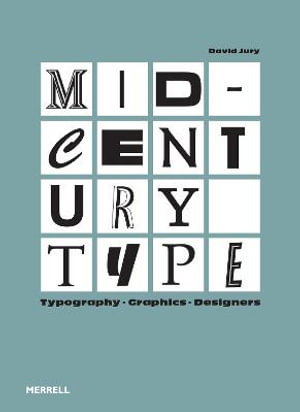| Tue | 9am – 5:30pm |
| Wed | 9am – 5:30pm |
| Thu | 9am – 5:30pm |
| Fri | 9am – 7pm |
| Sat | 9am – 5pm |
| Sun | 10am – 5pm |
| Mon | 9am – 8pm |
Ask our staff anything about our shop or products, or share your feedback.

PublishedMerrell Publications, November 2023 |
ISBN9781858947075 |
FormatHardcover, 240 pages |
Dimensions28cm × 20cm |
Mid-Century Type is a fascinating visual exploration of how, during the middle decades of the last century, the typographer became an independent, influential contributor to a fast-developing technological world of communications. The years after the Second World War were a time of great economic, social and cultural change as consumerism erupted across industrialized countries, fuelled by the growth of mass communication.
The same period was also one of exceptional creativity, including in the fields of typography and graphic design. During the war, governments came to appreciate the skill of designers in communicating public information effectively. Once the conflict was over, designers were recognized for the first time as having an essential role to play in the rebuilding of economies, infrastructure and public morale. The typographer, however, was still something of a 'Cinderella': type was crucial to communication in almost any medium, yet typography remained a vague and largely unacknowledged profession. This perception changed dramatically between 1945 and 1965. The range of media expanded, and the influence of time-based media such as television and film was profound, providing information 'as it happens' and transforming the turning of a page into the equivalent of the film editor's cut. 'Speed' was the elixir for growth and prosperity. The specific needs of motorway and airport signage were recognized as requiring the expertise of a typographer. Phototypesetting and offset lithographic printing coalesced to provide full-colour reproduction, which in turn vastly increased the sale of all printed material, but especially books and magazines. All of this drew typographers into what became established as specialist fields of printed and screen media. Finally, the cultural value of the typographer's work could be equated with that of the artist, poet, author and film director. Mid-Century Type charts this meteoric rise of the typographer and graphic designer (often one and the same person) during the early post-war decades. Each chapter is devoted to a specialist field of design activity in which typography played a significant role, from type design and corporate identity to advertising and film and television. David Jury's text offers fresh insight into the work of a wide array of British, European and American typographers, and is accompanied by some 350 illustrations, many from the author's own extensive collection. AUTHOR: David Jury is an award-winning typographer and graphic designer who lectures at the Cambridge School of Art, Anglia Ruskin University. His previous publications include Graphic Design Before Graphic Designers: The Printer as Designer and Craftsman, 1700 1914 (2012) and Reinventing Print: Technology and Craft in Typography (2018). He was formerly editor of TypoGraphic, the journal of the International Society of Typographic Designers. SELLING POINTS: . Explores a wide range of innovative work by European and American typographers during the mid-20th century . Written by a well-known print and typographic design historian . Profusely illustrated with 350 examples of typefaces, advertisements, book covers, specialist journals, posters and much more 475 illustrations

